#Bandai Azuma
Explore tagged Tumblr posts
Text



911 @ Fudosawa bridge
#carsonfilm#japan#classic cars#bessa#porsche#fukushima#Bandai Azuma#cayman#987#964#911#Carrera#portra 160#gummiboot
22 notes
·
View notes
Text

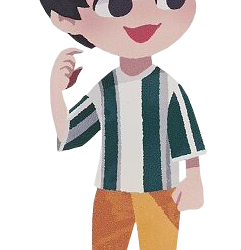
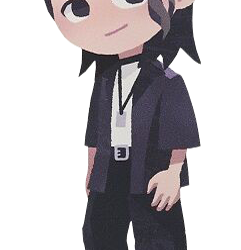



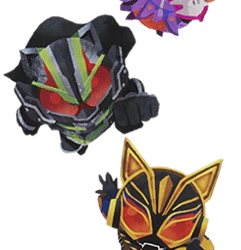


『仮面ライダーギーツ』デフォルメデザイン
#kamen rider geats#kamen rider#ace ukiyo#michinaga azuma#keiwa sakurai#neon kurama#win hareruya#tsumuri#official art#transparent#my edit#p-bandai#tokusatsu#kamen rider tycoon#kamen rider buffa#kamen rider na go#kamen rider punkjack#kamen rider ziin#png#cute#acrylic stand designs
378 notes
·
View notes
Text


磐梯吾妻スカイライン / Bandai-azuma Skyline - 20231017
30 notes
·
View notes
Text
Nishi-Azuma-Yama from Tengendai Kogen

We spent a restful night at Shirabu Onsen Nakaya Bekkan Fudokaku. The beautiful 100 year old onsen stands above the Otaru River a short distance from the Tengendai Resort Ropeway. They served us breakfast and we were quickly out the door.

Today’s goal was Nishi-Azuma-Yama, the high point of a broad volcanic mountain range that runs 12 miles from east to west. The best view is supposedly a lower volcanic crater on the eastern side of the range, but today’s objective was the highest point on the western side. This P3k caught my interest due to its inclusion in the Nihon Hyakumeizan book which documents the 100 Famous Mountains of Japan. We parked in the gravel lot at the Yumoto Station and got on the first gondola, departing at 8:20am. The ropeway climbed 1,400 feet in 6 minutes! It was an impressive feat of engineering. We disembarked at the Tengendai Ski Resort where we were greeted by a troop of monkeys.

We then had a short walk along a paved road to Natsuyama Lift. Even though it was still morning, it was very warm and humid out. After the very warm hike up Bandai-san the previous day, I was not looking forward to another sweaty outing.

The chairlift ride was broken up into three segments. All combined, this is the longest summer mountain lift in all of Japan. I watched other more honest mountaineers hike the trail below, raising questions internally if I was climbing the Hyakumeizan ethically. Maybe doing it the hard way is more rewarding, or maybe they simply didn’t want to spend the extra cash.


It took us 40 minutes to reach the Gomeiho View Terrace at 6,000 ft. Waiting this long was worth it since we were now less than 700 vertical feet below the summit. I appreciated every inch saved, since carrying Leif was starting to take a toll on me. Leif rang the bell for good luck and we were off.

We started off up a rocky trail through a thick jungle.

We transitioned into a subalpine climate zone in a matter of minutes and the views opened up.

Our objective lay on the other side of the saddle to our south.

The weather was much cooler than it was down below. It was like a completely different mountain. The same smells that I remembered from the Pacific Northwest filled my sinuses throughout the day.

There was even a boardwalk to protect the sensitive plant life. This made walking easy.


We passed by a spring source, which marks the headwaters of the Nakatsu River. While it is potable, we did not drink from it.

The trail became steep and rocky again but soon we were back on planks.

Leif voiced his interest to get out and walk so we let him stretch his legs.



The lower northern summit was adorned with big rocks. Spoiler alert; this was a better view point than the true summit.




There was a fork in the trail so we took the most direct path south. I was now more thankful for the planks because the ground underneath was swampy.


The berries next to the trail caught my eye, and I realized they were huckleberries. A quick verification with Seek confirmed my identification, so Leif and I foraged on some fresh fruit as we made our final ascent. Not only did it smell like the Pacific Northwest, but it tasted like it too.
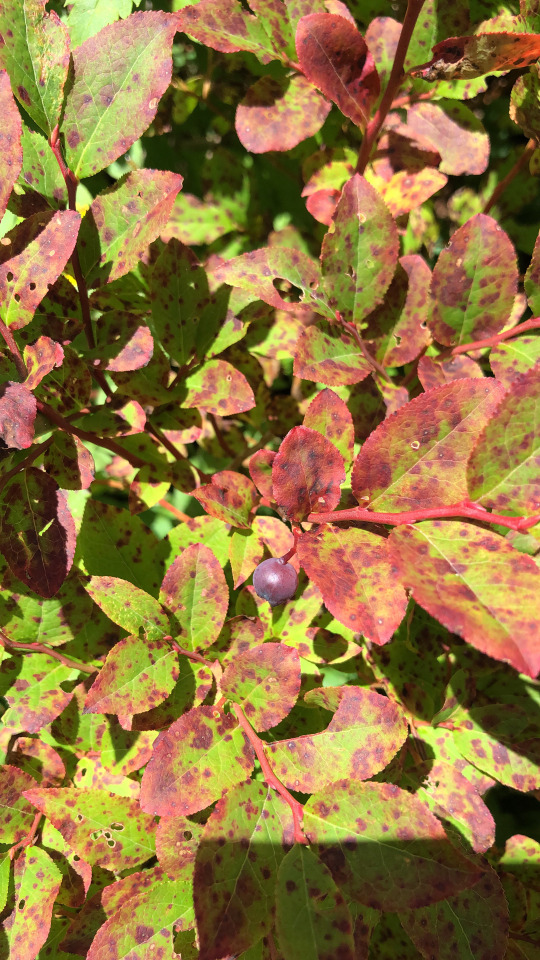
The designated “summit” of Nishi Azuma Yama was completely forested and a short distance away from the true summit. This is where most, if not all, hikers call it good.

From the sign, I left the others and bushwhacked straight into the thicket. It was really thick in places. After “swimming” for several minutes, I felt satisfied that I reached the high point and returned back to the trail. I sure hope I didn’t brush up against any urushiol.

From the summit we continued along the trail hoping to complete a small loop. To the southwest was Nishi-Daiten, a bonus peak which wasn’t appealing enough for me to visit.

Further south was Bandai-san, which we climbed just a day prior.

Back to the east was the summit of Nishi-Azuma-Yama.

We passed a hut and stopped for lunch along the planks.

Leif and I had fun playing with the dragonflies fluttering about.


After a few rice balls we continued “walking the plank” towards Tengu Iwa.

This rock pile had a shrine and some decent views. Any views were better than those from the true summit.





We completed our loop by returning to the north summit then we began our hike back towards the ski lift.


It was a last minute decision, but I decided to take a worthy detour to Ningyo Ishi, which roughly translates to Doll Rock. The effort was minimal and the reward was a fun class 3 summit block. It was spicy enough where I didn’t want pregnant Asaka or baby Leif to join me.

I had great views of Nishi-Azuma-Yama and Bandai-Asahi National Park.




Leif found inspiration from my performance and climbed several other smaller rocks nearby

From there we looped back down, taking a lesser used trail that connected us back to the top of the ski lift.

We had soft creams at the gondola to celebrate our success. It was a really nice day, and much more enjoyable than the day prior.

We then drove north to Kaminoyama where we spent the night.
0 notes
Photo






磐梯・吾妻 秋のオープンドライブ 2021年 (3) Enjoy the Japanese autumn at Bandai and Azuma area being into driving GOLF CABRIOLET, 2021 (3)
福島県会津地方の磐梯・吾妻エリアにある4つの観光道路、磐梯山ゴールドライン(Mt. Bandai Gold Line)、磐梯吾妻レークライン(Bandai-Azuma Lake Line)、磐梯吾妻スカイライン(Bandai-Azuma Sky Line)、西吾妻スカイバレー(Nishi Azuma Sky Valley)をターゲットに出かけました。 裏磐梯 (Ura-Bandai) や浄土平 (Johdodaira) での軽いトレッキング(というかウォーキング)も予定していたので、2泊3日では無理かなと思いながらのオープンドライブです。結果的には天候にもあまり恵まれず、写真撮影やトレッキングには不向き、また標高500~1700mと標高差があるので紅葉にも大きな差がありました。
磐梯山ゴールドライン (Mt. Bandai Gold Line); 猪苗代湖から向かいます。途中、星野リゾートの入り口付近にある街路樹(?)が素敵。ゴールドラインの途中には展望台もあり猪苗代湖も見えるのですが、天候のためかどこもやや平凡。峠を越えると、磐梯山への登山口が現れます。磐梯山爆裂火口の眺めで有名な黄金平展望台も、あっと!思っているうちに通り過ぎてしまい大失敗。紅葉はあまりパッとしない感じでした。檜原湖湖畔に出て終わりとなります。
五色沼 (Goshiki Numa); 裏磐梯の中心部にあり、ちょっと散策するのにも便利ですが、ここに限らず裏磐梯はどこでも熊に要注意だそうで、熊鈴が必須です!沼によって、エメラルドグリーン、コバルトブルー、ターコイズブルー、エメラルドブルー、パステルブルーと色が違う不思議な場所で「神秘の湖沼」と言われています。特に青沼は自然が作り出したものとは思えない綺麗な色だそうです(見ていません(苦笑))。もちろん、季節・天候・時間帯・見る方向で色彩は変わりますので、探照路のどちらから歩くかも一考です。
西吾妻スカイバレー (Nishi Azuma Sky Valley); 檜原湖北端から米沢に向かうスカイバレー。時間がなく、雨の中を檜原湖湖畔を廻るだけでしたが、裏磐梯中心部から延びる東側の湖畔道路がいい雰囲気でした。この檜原湖東側湖畔道路沿いにペンションは多いような感じでした。
磐梯吾妻レークライン (Bandai-Azuma Lake Line); 裏磐梯の中心部から出発。こちらにも展望台が点々とありますが、三湖パラダイス(檜原湖・小野川湖・秋元湖がそれぞれ見えるエリア)が一番有名なようです。こちらもあまり紅葉しているようには見えません。裏磐梯は、11月のカラマツの紅葉を待った方がよかったのかもしれませんね。途中の小野川不動滝・中瀬川渓谷は紅葉も見られず、時間も無いのでパス。
磐梯吾妻スカイライン (Bandai-Azuma Sky Line); レークラインからようやくスタート地点の土湯峠に到着。そう言えば、昔、晩秋に(新)野地温泉に来たときに、この土湯峠までちょっと来てみました。この時も悪天候かつ吹き飛ばされそうな強風で、向こうに見える裏磐梯も雲の中でした。走ってみると標高が高いせいもあり、このスカイラインがやはりダントツで、人気の高いのが良くわかります。有名な展望台が続きますが、少し見えていた磐梯山も安達太良山も雲と霧の中に消えてしまいました。紅葉もいい感じですが、勝手に��ルマを止められないし・・・・。浄土平に近づくにつれ濃霧となり、フォグランプも点灯です。
標高1600mの浄土平に到着、広大な駐車場と予想外に多い乗用車とバス(この悪天候下、コロナ禍の中、一応緊急事態宣言は解除になりましたが)に驚きます。浄土平で、トレッキングの身支度をして、天候回復を待ちますが、諦めて浄土平湿原・桶沼・吾妻小富士だけさらっと廻ります。結局ほとんど霧と小雨(泣)。せっかくここまで来たので、もう少し福島側に行ってみます。一切経山(活火山)の荒々しい岩肌のそばを通り抜け(硫黄ガスの匂いが車内まで入り込んで来ます)、濃霧の中を「天狗の庭」を過ぎ、つばくろ谷パーキングでUターン。当初目的の高湯温泉までは行けませんでした。裏磐梯への帰路はレークラインを通らずに、国道115線、459号線経由で戻ります。115号線は非常に快適な道路でびっくり!スピード違反に注意です(笑)。
おまけですが、檜原湖 (Hibara Lake) 湖畔から喜多方に向かう国道459号線も面白いです。峠越え、会津山塩(大塩裏磐梯温泉)の製塩工場、温泉やリゾートホテルなどのスポットあります。
それにしても、ちょっと駆け足すぎて反省です。
Bandai and Azuma area Japan, October 2021, CONTAX645, Phase One P30+, Planar T* 80 mm F2.0, Zonnar T* 140 mm F2.8
0 notes
Photo

吾妻火山 磐梯山山頂直下より
Azuma Volcano from Mt. Bandai-san.
#nature#landscape#mountain#mountain spotting#azuma range#azuma-san#azuma volcano#bandai-san#fukushima#japan#original photography#山座同定#吾妻山#磐梯山#福島
4 notes
·
View notes
Note
I wasn't asking for Chouki last time, but you know it IS a good idea, so gimme Chokey Dokey Literature Club (Cheaky Breaky Heart?)
This isn't related to Chouki but I just thought you'd like to know that that's the first nickname(?) you gave that really made me do a double-take, conjures up an indescribable feeling it does.
In any case, we can certainly talk about Chouki:

The New Emperor Amidst the Heat Haze — Taira no Chouki
Chouki's Story
A good chunk of Chouki's story takes part alongside Fumikado', and a good part of their character revolves around them as well, I'll be a lot briefer in this one, so go check out Fumikado's post if you want more context as to the why some of this stuff happens.
Chouki's Origins
Unlike Fumikado's origins, which are written in their profile from an omniscient narrator's view, what we have on Chouki's origins apparently come from Taira no Iwakado, who is frankly a rather fishy character. So we might need to take it with a grain of salt.
According to Iwakado, Chouki was born to a branch family of the Mugenri Taira. Much like Fumikado, they used to live in the imperial capital Devanagara with their own parents.
However, Chouki's parents would pass away in a political dispute (likely the same one that orphaned Fumikado), leaving Iwakado to take them in.
Iwakado raised Chouki to be Fumikado's servant, telling them to "always obey Fumikado, be by their side and aid them". That was their entire existence.
The Saeda
To that end, Chouki volunteered to play the magical Saeda flute in order to gather the souls needed for the revival plot. However, the flute could only be played by a "being closer to death", so they resolved to take their own life and become a ghost.
So Chouki made a deal with the master of the Spirit World in order to go against the world's natural order and remain the in the world of the living as a ghost.
However, the master played a nasty trick on them, taking their legs and breath from them when returning them to the living world. This left them incapable of playing the flute, and not long after, Fumikado cut them off from the plan.
Revenge
What Fumikado's intentions were, only they know, but Chouki felt betrayed, like they were tossed aside once they became useless. This feeling turned into hatred, and then a desire for vengeance.
In order to take down Fumikado, they trained under Garaiiya Ogata, Kaisen Azuma, Kujiru Kesa, as well as Gariaya's other shikigami, becoming proficient in both youkai arts and swordfighting.
It was when they began to match Fumikado's power that the Dragonfly Castle revealed itself to them, and welcomed them within. Thus they rose to the throne as the New Emperor of the Dragonfly Castle, and the rest is history.
Name: Taira no Chouki
There's not much to go over with Taira (平), but in Chouki (蝶鬼), "chou" (蝶) means "butterfly" and "ki" (鬼) refers to the youkai oni.
Notably, while it rarely takes this meaning in Japanese (not never though), it almost always means "ghost" in Chinese.
Inspiration: Nyozou-ni
Chouki lightly references Taira no Masakado's 3rd daughter, the Buddhist nun Nyozou-ni, whose birth name is lost to history.
The best historical sources we have on her are the Konjaku Monogatarishū (今昔物語集), a collection of various tales written during the late Heian period, and the Genkō Shakusho (元亨釈書), Japan's first Buddhist history text.
Both tell the same general tale, that to punish Masakado's family for his crimes, his 3rd daughter was exiled to live alone next to an Enichi Temple where she eventually died of illness. (There are two likely candidates that Enichi Temple in the texts refer to, but it is unclear which one it is.)
Depicted below: Enichi Temple's main hall.

She then fell to hell but was rescued by the Buddha Jizou and came back to life, after which she converted to Bhuddism and became a nun known as Nyozou-ni (如蔵尼) or Jizou-ni (地蔵尼).
Nyozou-ni's gravestone at the Enichi Temple in Bandai Town, Fukushima Prefecture reads:
"Takiyasha-hime tried to restore [the clan/her position] after Masakado's death, but failed and became a nun"
It's not exactly clear what she is said to have tried to restore, but this is where we get the name "Takiyasha-hime" from, as well as the idea that she tried to change the outcome of Masakado's rebellion in some sense.
Depicted below: Nyozou-ni's gravestone at the Enichi Temple

While Chouki's story doesn't rely on Nyozou-ni that heavily, it's possible that their visit to and return from the Spirit World is based on Nyozou-ni's own death and revival story.
Inspiration: Takiyasha-hime
Chouki is more heavily based on a mythologized version of Nyozou-ni, Takiyasha-hime (滝夜叉姫).
Her mythologization is believed to date back only to the 17th century, in the 1806 yomihon novel series "The Tale of Utou Yasutaka's Loyalty" (善知安方忠義伝) by Santō Kyōden. (Yep this book again lol)
The books are an attempt to combine the Noh play "Utoh" (善知鳥 Auklets) and the Masakado legends, which is notable because one of Chouki's spells, "The Auklet's Cry, and the Response Thereto", actually reference Utoh directly.
In the novels, she is instead initially known as Kisaragi-ni (如月尼). A Buddhist nun who lives on Mount Tsukuba raising her younger half-brother Taira no Yoshikado (平 良門), something the historical Nyozou-ni is also said to have done (although its veracity is unclear).
Depicted below: Kisaragi-ni (left page) and Yoshikado (right page)

After Masakado indeed failed and was executed, a powerful toad spirit that lived on the mountain, Nikushi-sen (肉芝仙), revealed himself to the siblings and told them the truth of their origins.
He taught them both toad magic, convinced them to restart their father's rebellion, and possessed Kisaragi-ni, transforming her into Takiyasha-hime.
Depicted below: Takiyasha-hime in one of the books (left), Nikushisen (as a toad) and Yoshikado (above the toad)

Takiyasha-hime's paring here with Yoshikado may have inspired Chouki's initial collaboration with Fumikado, while their learning magic from Nikushi-sen may be inspired Chouki's later training with Garaiya, Kaisen, Kujiru and co.
At the climax of the story, Ooya Tarou Mitsukuni (大宅太郎光圀) was sent to seek out any remnants of Masakado's rebellion, and tracked them all the way to Soma's old imperial palace (相馬の古内裏), an old palace modeled after the Emperor's that used to be Masakado's base of operations, where the siblings have been recruiting people still loyal to Masakado's cause.
In a desperate attempt to fight back, the siblings summon and control an army of skeletons to fight back against Mitsukuni and his men but ultimately lose.
Depicted below: Ooya Tarou Mitsukuni fighting off the skeletons.

The end of the story is unknown as the series was never completed, although one could assume that Takiyasha-hime will eventually go to Enichi Temple and become a nun there, reconciling this tale with history.
So that's the general story of Takiyasha-hime in the myths: Masakado's daughter awakens to magic and becomes Takiyasha-hime, hides out at Soma's old imperial palace, summons skeletal monster(s) that Ooya Tarou Mitsukuni defeat.
But the legends would continue to evolve and change, leading to some further references:
Exclusion of Yoshikado and Nikushi-sen
As the Takiyasha-hime myths evolved, she began to be divorced from the characters of Yoshikado and Nikushi-sen, becoming the only central character of the story.
This is potentially referenced in how Chouki would eventually part ways with Fumikado, although I admit I'm not 100% sure about this.
Identification with Masakado's 1st daughter, Satsuki-hime
As the legends evolve, Tskiyasha-hime would sometimes be identified with Masakado's first daughter instead, Satsuki-hime (五月姫 may princess/lady). Here "satsuki" probably is meant to refer to the Rhododendron indicum, and not the actual month of May.
This is referenced in the spell Tearing Card "May Flowering".
Depicted below: A satsuki blossom.
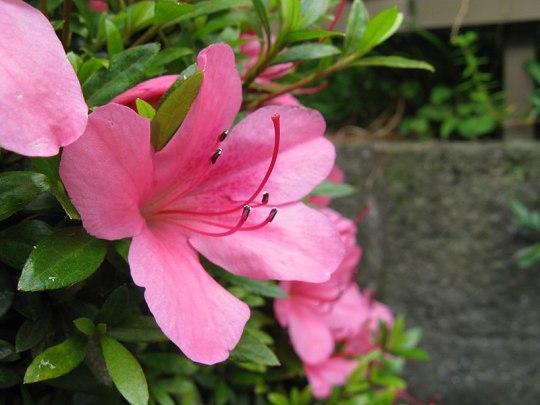
The Ox-hour Shrine Visit
In the tales where Takiyasha-hime was Satsuki-hime, she is often given a very different story regarding her transformation into Tskiyasha-hime.
After Maskado's defeat and subsequent death, all his family and servants were executed as well, but Satsuki-hime somehow survived.
Harbouring extreme hatred for her enemies, she started performing a fearsome curse ritual called the "ox-hour shrine visit" at the Kifune Shrine (貴船神社).
On her 21st night performing the curse, she hears the voice of the rough and violent spirit of the shrine's god, Takaokami-no-Kami, who teachers her sorcery, transforming her into Takiyasha-hime.
This was referenced in the spell "Ox-Hour Visit to Kifune Shrine".
Additionally, this was a popular subject for artists of the time, like in the following woodblock print by Utagawa Toyokuni, which was referenced in Chouki's design as well.

Summoning the Gashadokuro
Based on the climactic scene in the original "The Tale of Utou Yasutaka's Loyalty", Utagawa Kuniyoshi made the woodblock print "Soma's old imperial palace" (相馬の古内裏), where a single giant skeleton is summoned instead of multiple normal-sized ones.
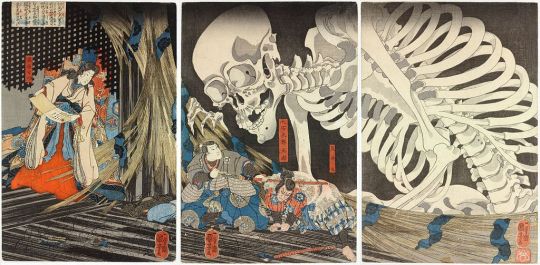
While the gashadokuro is a modern invention from the 1960s, it has been identified with the skeleton in this piece, and the idea that Takiyasha-hime summoned a gashadokuro to fight her enemies was firmly solidified in the public imagination.
This was referenced in the spells Summoning "Gashadokuro" and "Soma's Old Imperial Palace".
And I think that's all! I would say let's look forward to what else they do but they're not showing up in Golden Chapter and almost certainly not MW, so uhh, let's hope BotC at least gives us something more~! :)
12 notes
·
View notes
Photo



Guess who arrived today? Fuck yeah! He looks awesome
#tiger mask w#tiger mask#naoto azuma#sh figuarts#figure#bandai#wrestling#pro wrestling#anime#manga#tiger-mask-w
44 notes
·
View notes
Text
Urabandai Autumn Foliage Ropeway" is now in operation. Enjoy the 100 most famous mountains in Japan and Bandai-Asahi National Park
Urabandai Autumn Foliage Ropeway” is now in operation. Enjoy the 100 most famous mountains in Japan and Bandai-Asahi National Park
Tokyu Resorts & Stay has started operating the “Urabandai Autumn Foliage Ropeway” to enjoy the autumn foliage of Bandai, Adatara, and Nishi-Azuma Mountains, Japan’s 100 most famous mountains, in Bandai-Asahi National Park. The ropeway runs from October 1 to November 6. The autumn foliage at Grandeco Resort in Bandai-Asahi National Park begins to change color in late September with the native…
View On WordPress
0 notes
Text
Kojima Sohonten Co., Ltd.


Address 2-2-3 Honmachi Yonezawa City, Yamagata Prefecture Date Established Company established in 1952. Business founded in 1597. Representative President: Kojima Kenichiro History Kojima Sohonten is a sake brewery that was founded in year two of the Keicho era (1597), during the Azuchi-Momoyama period. It is the 13th oldest extant sake brewery in Japan, and is one of the few sake breweries that opened before the Edo period to still be in operation today. In year six of the Keicho era (1601), not long after opening, the brewery became a sake provider for the Uesugi clan after daimyo Uesugi Kagekatsu came to Yonezawa. Rice was often scarce due to famine during the Edo period, and sake prohibitions were put in place to help save the invaluable crop, but the Kojima Brewery was one of the few brewers still allowed to continue making sake. Its famous sake, “Toko” ("Eastern Light"), gets its name from the fact that the brewery is located in the direction of the rising sun when seen from Yonezawa Castle. In other words, it is “Yonezawa’s sunrise sake.” Warehouse Features, Manufacturing Philosophy Our brewery does not add any brewer’s alcohol (jozo alcohol) or import spirits. All of our sake is brewed without adding any alcohol or sugar. While industrially brewed sake may be reasonably priced and more economical, we believe that true Japanese sake joins rice that has been blessed by the sun and earth together with underground water that has melted from snow and lapped at the earth’s crust, and marries the two together with microbes to be brewed. Therefore, we honor our rule to only brew without added alcohol or sugar. Besides Japan, Toko is now enjoyed in about 20 different countries and regions. This gives us confidence that the beauty inherent in carefully made Japanese sake can transcend borders and cultures. Moving forward, we aim to further deepen our roots in local customs and cultures, and continue striving to brew sake that connects with the hearts of our customers. Features of the Area (Geography/Weather/Local Culture, etc.) Yonezawa is located at the southernmost tip of Yamagata Prefecture, in the flatlands of Yonezawa among the plains of the Azumi mountain range, where the source of the Mogami River, “the mother river”, can be found. The summers are hot and humid, and the annual rainfall is slightly low compared to the national average. Winters are harsh, and the area is specially designated as a heavy-snowfall region. The average total annual snow accumulation can be as much as 10 m, and snow can become as deep as 100 cm in urban areas. The Azuma Mountains, which spread out from the south of the city, are mostly located within Bandai Asahi National Park, allowing people to enjoy grand natural landscapes that change with the seasons. People can also easily enjoy an abundance of hot springs year round, mountain climbing in the summer, and skiing in the winter, making the city “rich with the blessings of nature.” Yonezawa lost the look of its old cityscape to major fires that broke out in 1917 and 1919, but there nevertheless remain many cultural treasures of the past, including national historical sites like the Uesugi Clan Mausoleum and Uesugi Harunori keishi kougei ato (the site where Uesugi Harunori went to greet his mentor), as well as national treasures like the “Rakuchu rakugai zu” paintings that depict scenes in and around the capital, and the “Uesugi Monjo” writings. For this reason, the city is visited and enjoyed by many as “the castle town of the Uesugi clan.” Annual rainfall/snowfall/sun Average annual rainfall: 1950 mm. Average annual snowfall: 711 cm. Average number of days of sunshine: 66 days Annual high/low temperatures (°C) Yearly high: 29℃. Yearly low: -7℃

0 notes
Text




「Idol Cadet × IDOLiSH7 | Rhythm Game × N, R Card | Illustration」
• Maki Homare
• Sengoku Azuma
Credit: BANDAI NAMCO Online | Tanemura Arina
0 notes
Photo





#kamen rider geats#kamen rider#ace ukiyo#keiwa sakurai#neon kurama#michinaga azuma#tsumuri#official art#transparent#my edit#please give credit#do not repost#p-bandai#png#tokusatsu
153 notes
·
View notes
Text




磐梯吾妻スカイライン / Bandai-azuma Skyline - 20231017
20 notes
·
View notes
Photo

😌🍃🍃🐒🌳 ・ ・ ・ #japan #fukushima #bandaiazumaskyline #fog #mist #faze #nature #aftertherain #beautifulnature #lovenature #woods #mountain #driving (at Bandai-Azuma Skyline)
#fog#mountain#aftertherain#japan#fukushima#nature#bandaiazumaskyline#woods#driving#mist#faze#lovenature#beautifulnature
1 note
·
View note
Photo









磐梯・吾妻 秋のオープンドライブ 2021年 (2) Enjoy the Japanese autumn at Bandai and Azuma area being into driving GOLF CABRIOLET, 2021 (2)
福島県会津地方の磐梯・吾妻エリアにある4つの観光道路、磐梯山ゴールドライン(Mt. Bandai Gold Line)、磐梯吾妻レークライン(Bandai-Azuma Lake Line)、磐梯吾妻スカイライン(Bandai-Azuma Sky Line)、西吾妻スカイバレー(Nishi Azuma Sky Valley)をターゲットに出かけました。
裏磐梯 (Ura-Bandai) や浄土平 (Johdodaira) での軽いトレッキング(というかウォーキング)も予定していたので、2泊3日では無理かなと思いながらのオープンドライブです。結果的には天候にもあまり恵まれず、写真撮影やトレッキングには不向き、また標高500~1700mと標高差があるので紅葉にも大きな差がありました。
磐梯山ゴールドライン (Mt. Bandai Gold Line); 猪苗代湖から向かいます。途中、星野リゾートの入り口付近にある街路樹(?)が素敵。ゴールドラインの途中には展望台もあり猪苗代湖も見えるのですが、天候のためかどこもやや平凡。峠を越えると、磐梯山への登山口が現れます。磐梯山爆裂火口の眺めで有名な黄金平展望台も、あっと!思っているうちに通り過ぎてしまい大失敗。紅葉はあまりパッとしない感じでした。檜原湖湖畔に出て終わりとなります。
五色沼 (Goshiki Numa); 裏磐梯の中心部にあり、ちょっと散策するのにも便利ですが、ここに限らず裏磐梯はどこでも熊に要注意だそうで、熊鈴が必須です!沼によって、エメラルドグリーン、コバルトブルー、ターコイズブルー、エメラルドブルー、パステルブルーと色が違う不思議な場所で「神秘の湖沼」と言われています。特に青沼は自然が作り出したものとは思えない綺麗な色だそうです(見ていません(苦笑))。もちろん、季節・天候・時間帯・見る方向で色彩は変わりますので、探照路のどちらから歩くかも一考です。
西吾妻スカイバレー (Nishi Azuma Sky Valley); 檜原湖北端から米沢に向かうスカイバレー。時間がなく、雨の中を檜原湖湖畔を廻るだけでしたが、裏磐梯中心部から延びる東側の湖畔道路がいい雰囲気でした。この檜原湖東側湖畔道路沿いにペンションは多いような感じでした。
磐梯吾妻レークライン (Bandai-Azuma Lake Line); 裏磐梯の中心部から出発。こちらにも展望台が点々とありますが、三湖パラダイス(檜原湖・小野川湖・秋元湖がそれぞれ見えるエリア)が一番有名なようです。こちらもあまり紅葉しているようには見えません。裏磐梯は、11月のカラマツの紅葉を待った方がよかったのかもしれませんね。途中の小野川不動滝・中瀬川渓谷は紅葉も見られず、時間も無いのでパス。
磐梯吾妻スカイライン (Bandai-Azuma Sky Line); レークラインからようやくスタート地点の土湯峠に到着。そう言えば、昔、晩秋に(新)野地温泉に来たときに、この土湯峠までちょっと来てみました。この時も悪天候かつ吹き飛ばされそうな強風で、向こうに見える裏磐梯も雲の中でした。走ってみると標高が高いせいもあり、このスカイラインがやはりダントツで、人気の高いのが良くわかります。有名な展望台が続きますが、少し見えていた磐梯山も安達太良山も雲と霧の中に消えてしまいました。紅葉もいい感じですが、勝手にクルマを止められないし・・・・。浄土平に近づくにつれ濃霧となり、フォグランプも点灯です。
標高1600mの浄土平に到着、広大な駐車場と予想外に多い乗用車とバス(この悪天候下、コロナ禍の中、一応緊急事態宣言は解除になりましたが)に驚きます。浄土平で、トレッキングの身支度をして、天候回復を待ちますが、諦めて浄土平湿原・桶沼・吾妻小富士だけさらっと廻ります。結局ほとんど霧と小雨(泣)。せっかくここまで来たので、もう少し福島側に行ってみます。一切経山(活火山)の荒々しい岩肌のそばを通り抜け(硫黄ガスの匂いが車内まで入り込んで来ます)、濃霧の中を「天狗の庭」を過ぎ、つばくろ谷パーキングでUターン。当初目的の高湯温泉までは行けませんでした。裏磐梯への帰路はレークラインを通らずに、国道115線、459号線経由で戻ります。115号線は非常に快適な道路でびっくり!スピード違反に注意です(笑)。
おまけですが、檜原湖 (Hibara Lake) 湖畔から喜多方に向かう国道459号線も面白いです。峠越え、会津山塩(大塩裏磐梯温泉)の製塩工場、温泉やリゾートホテルなどのスポットあります。
それにしても、ちょっと駆け足すぎて反省です。
Bandai and Azuma area Japan, October 2021, CONTAX645, Phase One P30+, Distagon T* 55 mm F3.5, Planar T* 80 mm F2.0, Zonnar T* 140 mm F2.8, Zonnar T* 210 mm F4.0
0 notes
